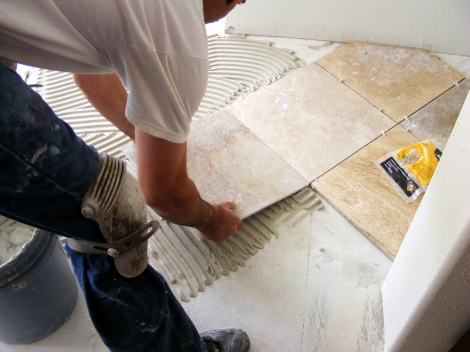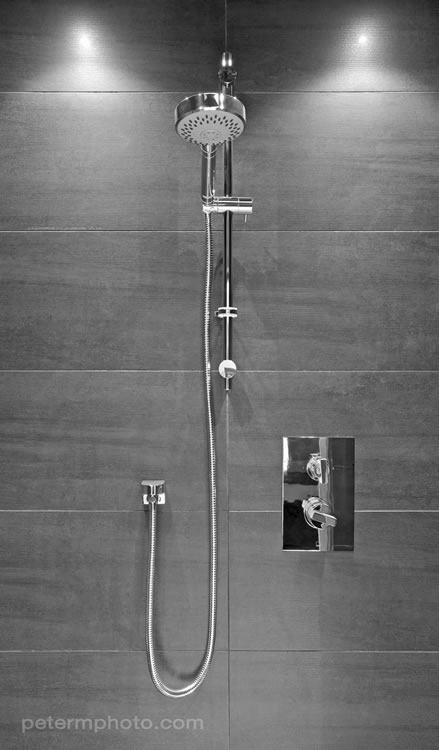Porcelain Tiles & Ceramic Tiles – What’s the Difference?
When all you want to do is choose a wall tile that you like the look of, it can be frustrating to be bombarded with technical detail about the tiles. But if those beautiful-looking tiles are going to stand the test of time, particularly if they are floor tiles then you do need to know some of the technical stuff.
For example, most people refer to ceramic tiles and porcelain tiles inter-changeably – many people just refer to all wall tiles are ceramic. So it’s little wonder there is some confusion especially since both types are made from clay (or a clay mixture). But the way in which they are made is quite different and has an enormous effect on the end-product, particularly in terms of their strength, durability and resistance to frost.
Ceramic tiles are made by moulding a pliable mixture of clay, minerals and water into a tile shape. They are fired in a kiln and then usually have a glaze applied in a range of colours and patterns. They can be used as wall tiles and floor tiles, providing the floor is not subject to heavy traffic, so are suitable for most domestic uses.
 Porcelain tiles are made from very finely milled raw materials (which can include coloured minerals) and compressed in moulds under high pressure to remove gaps between the particles. They are then fired in the kiln at very high temperatures to form a dense and very strong tile. Porcelain tiles are also highly waterproof making them frost-resistant. They can either be glazed, with the colour and pattern as part of the glaze, or “full bodied” where the colour and pattern runs through the entire thickness of the tile. The full-bodied type are the most hard-wearing but even glazed porcelain tiles are much harder-wearing than glazed ceramic tiles.
Porcelain tiles are made from very finely milled raw materials (which can include coloured minerals) and compressed in moulds under high pressure to remove gaps between the particles. They are then fired in the kiln at very high temperatures to form a dense and very strong tile. Porcelain tiles are also highly waterproof making them frost-resistant. They can either be glazed, with the colour and pattern as part of the glaze, or “full bodied” where the colour and pattern runs through the entire thickness of the tile. The full-bodied type are the most hard-wearing but even glazed porcelain tiles are much harder-wearing than glazed ceramic tiles.
The Porcelain Enamel Institute has a rating scale that indicates the areas most suited to the use of a particular tile (but note that it is not a quality rating). The PEI scale ranges from 0 to 5 with 0 being the most fragile tile suitable as wall tiles only and 5 indicating suitability for high traffic floor tiles.
The Scale:
Class 0 – No Foot Traffic:
Suitable for wall tiles only and should not be used on floors.
Class 1 – Very light traffic:
Very low foot traffic, bare or stocking feet only. (eg. Master bathroom)
Class 2 – Light Traffic:
Slipper or soft-soled shoes. (eg. family bathroom, bedrooms)
Class 3 – Light to Moderate Traffic:
Suitable for any residential area except hallways and kitchens where extremely heavy or abrasive traffic is anticipated.
Class 4 – Moderate to Heavy Traffic:
For high foot traffic areas where abrasive or outside dirt is likely. (eg, Residential entrance, kitchen, balcony)
Class 5 – Heavy Traffic:
For residential, commercial and institutional floors subjected to heavy traffic.





5 Responses
[…] What are Ceramic tiles? Ceramic tiles are made from clay fired in a kiln. A coloured glaze is added, and the tile is fired again, making the colours that have been applied come alive in vivid variations. Ceramic tiles can be slippery, so they are usually treated with an abrasive if they are to be used as floor tiles. Unglazed ceramic tiles, called quarry tiles, are also available. They stain easily, so they should be sealed for use as flooring. Remember that slick surface tiles are not ideal in places like the bathroom, pool changing rooms, or anywhere water may collect. […]
[…] should have the replacement tiles in hand. If you have a common tile style you should be able to find new ceramic or porcelain tiles at any home improvement store. Also you need to have the replacement grout before you get the job […]
[…] you have chosen your tiles, whether they are ceramic tiles, porcelain tiles or natural stone tiles, you will need to buy the appropriate adhesive and grout (this will depend on the type of tiles you […]
[…] tiled entrance hall or a marble bathroom and these can really add value to your existing home. Ceramic tiles or porcelain tiles simply don’t have the same […]
[…] may not be willing to go so far as learning about the manufacturing process of ceramic or porcelain tiles but here at least is a glossary of the most common terms used in the ceramic tile trade so that you […]